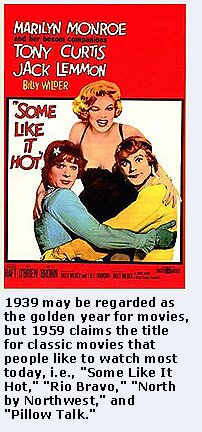   |
|
Classic Movie Metric Noun, e.g., According to the Classic Movie Metric, a cable station will generate a bigger audience showing “Pillow Talk” (1959) than it will “Ben-Hur” (1959).
History: The theory was extrapolated by the late film historian Arnold Ripley from ratings of old movies televised during the 1990s. Ripley claimed the most watched oldies (movies 25 years or older) were rarely Academy Award winners for best acting, direction or picture. Rather, top favorites included the likes of “Shall We Dance” (1937), “Rio Bravo” (1959), “A Wonderful Life (1946), ”North by Northwest” (1959), “Lover Come Back,” (1961), “The Big Sleep” (1946) “Some Like It Hot” (1959). The common denominator of these films is that they star actors appreciated more for their individual personas than their acting, e.g., Fred Astaire, John Wayne, Jimmy Stewart, Cary Grant, Doris Day, Humphrey Bogart and Marilyn Monroe. Ripley introduced the theory as a “metric” among others in an article titled “Lasting Stars, Diminishing Stars & Imploding Stars” published by the Journal of the American Marketing Association. The label of “Classic Movies Metric” was applied by advertising and marketing executives who adhered to the principle when buying T.V. air time. Each actor cited by Ripley made multiple films in which he or she displayed a persona that was consistent, complex and likeable. Often these films were made consecutively or within a short period, such as John Wayne's fan favorites “Rio Bravo” (1959), “Hatari!” (1962), “Donavan’s Reef” (1963), “McClintock!” (1963), and “El Dorado” (1966). Throughout his career, John Wayne the actor played a rugged individualist, a man’s man and a champion of right against wrong. In his most popular movies, however, he is that and more, e.g., a man who is part of a group of close-knit and interdependent friends, a man vulnerable to teasing and bullying by the opposite sex, and a man at home with his friends in a house (“Hatari!,” “McClintock!”), a sheriff’s office (“Rio Bravo,” “El Dorado”), or a saloon (“Donavan’s Reef”). There is a good deal of “table talk” in the Duke’s popular oldies. Today most the movies Ripley cited continue to be popular judging by the frequency with which cable networks broadcast them. Movies like “Rio Bravo” and “North by Northwest” total far more broadcasts in a year than any Oscar winner for best picture. On the other hand, Hollywood no longer makes the icons it once did. Big names whose films now qualify as classic played roles not personas, and while someone like Jack Nicholson did both, his persona is borderline whacko. Clint Eastwood probably best fits the bill, and yet the range of his persona is always tilted toward edginess, compared to the nuances of a Bogart, who benefited from making four films with the woman he loved. |
 Definition: The rule that, in general, people prefer classic movies that star actors who act the least and play themselves the most.
Definition: The rule that, in general, people prefer classic movies that star actors who act the least and play themselves the most.